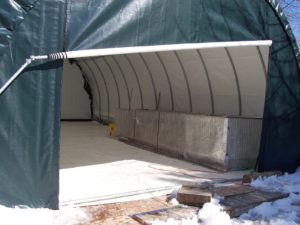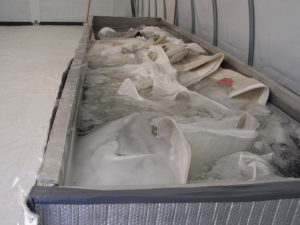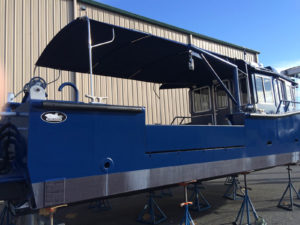What ‘slow season’?
 Indoor work, alternative income streams help fabricators get through the off-season.
Indoor work, alternative income streams help fabricators get through the off-season.
Boating in many locations is seasonal, but the need for income is constant. How do marine fabricators handle that conundrum? A variety of strategies offer ways that canvas shops can use to get ready for seasonal slow-downs in business.
‘The Great Shrink-wrap Race’
“We have what we refer to every fall as ‘The Great Shrink-Wrap Race,’” says Mark Hood, MFC, who, with his wife, Deb, owns Hood Marine Canvas and Training in Merrimac, Mass. “The race is to make all the patterns on the boats that we need for our winter work before our customers’ boats are shrink-wrapped for the winter” to ensure off-season projects. “As a small shop, it does not take a large volume of work to get through the off-season; just make sure it is profitable and you have charged enough.” And, he adds, “Encourage customers to put off interior or cushion work until the off-season. Not everyone will wait, but a good majority will.”
Incentivize customers …
One way to motivate customers to wait is to offer a discount, as owner Greg Keeler does at Oyster Creek Canvas in Bellingham, Wash.

At Hallett Canvas & Sails Inc. in Falmouth, Maine, customers can have their canvaswork cleaned in a special tank while their boat sits out the winter weather.
“As far as financial incentives to the customers, I mostly convey that verbally,” Keeler explains. “We get really busy spring through fall, and it does slow a bit in the dead of winter. So when a customer brings me a project such as new cushions or a top for their boat and says, ‘No hurry,’ I let them know that I would love to see their boat in the shop in December or January, and I could probably do a bit better on the price when things are a bit slower. I tell customers, ‘Go out and use the boat the rest of the season, beat it up, get it fishy and pull it in here in the middle of winter … and come spring it will be all new and ready to go!’”
Financial incentives work for Hallett Canvas & Sails Inc. in Falmouth, Maine, too. “Offering our discounts and removal of sails and canvas has been a huge help for us,” owner Richard Hallett says. “We offer a 10 percent discount for customers who sign up for winter canvas storage by Dec. 15. The 10 percent can increase to 15 percent if customers choose to buy sets of sails if they find both sails, or all sails, are in poor shape and need replacing.”
But incentivize selectively
Consider being selective about which customers get which discounts, and when those incentives are offered. That approach works for Charles Klein, owner and founder of Dorsal LLC in Sturgeon Bay, Wis., for whom “… the weeks leading up to Memorial Day and the Fourth of July weekend are the core of our season. We do offer a 10 percent end-of-the-year discount after Labor Day until New Year’s for individual customers if a marina or boatyard is not involved. Our commercial customers are the largest and most important part of our customer base, and we offer them a 13 percent discount.”
Discounts needn’t apply to all work performed during a fabricator’s slow period, though. Chris Lohmann of Lohmann Sails and Covers Ltd. in Ladysmith, British Columbia, does not offer price reductions for the winterizing and boat-storage services that customers can sign up for on his website. Because Lohmann’s busiest season is fall, when he makes winter covers for boats, “I give a 10 percent off-season discount if customers order new covers in my off-season from March to [the] end of June,” he says. Further helping to drive projects to his annual lull as a way to generate year-round income is the fact that Lohmann’s website specifies repairs and other maintenance services are available only from March through July. In addition, minimizing advertising expenses helps preserve income. “Since I am the only company in the Pacific Northwest doing only winter covers, I do no advertising at all beside a classified ad in Pacific Yachting, running the whole year so people with no Internet can find me.”

As part of the “winter service program,” the cleaning service at Hallett Canvas & Sails features a cleaning agent that performs like bleach but does not harm textiles as bleach can and consequently does not cause color to fade.
Off-season storage
Boats aren’t the only items that can be stored to augment income, although not every fabricator does so, whether due to lack of space, insurance costs or labor constraints. Lohmann overwinters boats (in addition to offering installation, take-down, repair and cleaning) while Oyster Creek Canvas’ Keeler does not. “I don’t store boats and have room in my shop for only one or two at a time,” he explains. At The Canvas Shop of Avon, on the New Jersey coast, “We don’t store canvas for insurance reasons, and we don’t reinstall [canvas] due to manpower and time constraints, although we do offer discounts for work scheduled for the winter slower season,” explains the company’s general manager, who declined to give his name.
At Hallett Canvas & Sails, “We provide what we call a ‘winter service program’: We clean canvas and do repairs,” says Hallett, who also stores sails and canvas. Hallett’s cleaning and repair services are promoted on his website by warning customers of the damage that can occur if sails and canvas aren’t examined to detect needed repairs, repaired as necessary and cleaned at the end of a season on the water. Cleaning is done in a specially designed wash tank Hallett installed in 2011, and uses a cleaning agent that performs like bleach but does not harm textiles as bleach can and consequently does not cause color to fade.
Supplies
Some marine fabricators stock up on supplies before their lull begins; others don’t.
“I definitely try to stock up on general supplies throughout the summer months, and the reason why is easy,” Keeler says. “I make more money in the summer, and having a good stockpile of hardware and materials is like a savings account. I do the same thing with heat, in a way. I have a large natural-gas shop heater, so during the months that it’s not on, I still pay monthly so that when it does get cold, it doesn’t seem as painful to crank up the heat. And my shop does get cold in the winter.”
Lohmann, on the other hand, prefers to “buy supplies when I get offered deals. Having said that,” he clarifies, “I always have a one- to two-year stock in my shop so I don’t have to buy fabric when it is expensive.” That outlook’s echoed by Hood, whose opinion is that, “It is not necessary to order materials in advance of the off-season—most shops are within one-day UPS delivery—unless there is a cost advantage.”
The Canvas Shop of Avon’s philosophy is to “… try to use up stock from the previous season in order to increase profit margins a little. Come spring, we’ll reorder,” according to the shop’s general manager.
And, some shops employ both approaches to ordering. “We don’t need to stock canvas or cloth because we order what’s needed for each individual job,” Hallett says. But, he adds, “For hardware, we make sure to have a healthy inventory on hand.”

Greg Keeler of Oyster Creek Canvas in Bellingham, Wash., encourages his customers to enjoy their vessel during the season, then bring it in for overall cleaning and repair during the winter.
Employee management
It might seem like a prudent economic decision to reduce your workforce when work slows, but Kate Mitchell of The Boat Shop at Nomar in Homer, Alaska, points out the downside of that thinking. “It drives you crazy to try to find help” if employees are let go during the off-season, she says, if “they can’t return when business picks up because they’ve found other employment.” Mitchell started out making boat tops but “had to diversify to survive,” which now keeps her employees occupied year-round. Nor are employee hours reduced at any time during the year at Hallet Canvas & Sails. That’s because “We don’t have an off-season,” Hallett says. “If there is a slower season, it would be mid-September to mid-October. That’s a decision-making time; people are deciding what they want to do before they put the boat away for the winter.
In contrast, says Keeler at Oyster Creek Canvas, “My employees understand that things do slow down a bit in the winter, so they plan accordingly. I am lucky to have such great employees that are self-motivators and understand the dynamics of the shop and have other things going on besides just work (teaching quilting at the community college, farming, community organizing …) … If it did get really slow, I would find something for them to do if it became an issue. There is always something to do to improve the workspace.”
And even if business does experience a seasonal slow-down? Depending on who you’re talking to, that may not be entirely unwelcome. “If we are lucky there is a lull toward late summer/early fall, we can get on the water ourselves,” says Dorsal’s Klein.
Janet Cass is an editor and writer based in St. Paul, Minn.
 TEXTILES.ORG
TEXTILES.ORG 






